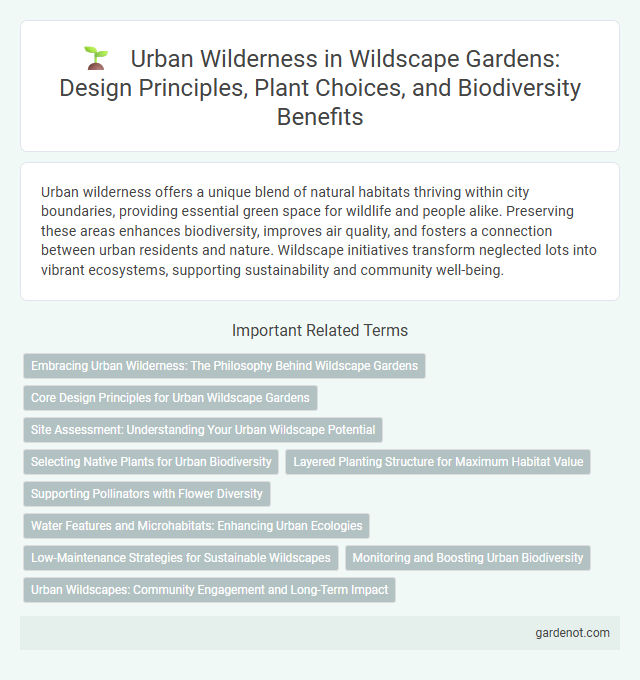Urban wilderness offers a unique blend of natural habitats thriving within city boundaries, providing essential green space for wildlife and people alike. Preserving these areas enhances biodiversity, improves air quality, and fosters a connection between urban residents and nature. Wildscape initiatives transform neglected lots into vibrant ecosystems, supporting sustainability and community well-being.
Embracing Urban Wilderness: The Philosophy Behind Wildscape Gardens
Wildscape gardens embody the philosophy of embracing urban wilderness by fostering native plants and wildlife habitats within city environments, promoting biodiversity and ecological balance. These gardens serve as vital green spaces that reconnect urban communities with nature, supporting pollinators, birds, and small mammals while improving air quality and reducing urban heat. By integrating natural landscapes into metropolitan areas, Wildscape cultivates resilient ecosystems that enhance both environmental health and residents' well-being.
Core Design Principles for Urban Wildscape Gardens
Core design principles for urban wildscape gardens prioritize native plant species to support local biodiversity while enhancing ecological resilience in city environments. Emphasis on layered vegetation structure creates habitat complexity that attracts and sustains diverse wildlife populations. Incorporating water features and naturalistic soil management promotes nutrient cycling and microhabitat variety essential for urban ecosystem health.
Site Assessment: Understanding Your Urban Wildscape Potential
Assessing your urban wildscape potential involves evaluating site-specific factors such as soil quality, sunlight exposure, existing vegetation, and local wildlife presence. Understanding these elements helps identify opportunities to create diverse habitats that support native species while enhancing ecological connectivity. Accurate site assessments guide sustainable planting strategies and resource management, maximizing biodiversity within urban environments.
Selecting Native Plants for Urban Biodiversity
Selecting native plants for urban wilderness enhances biodiversity by providing essential habitats for local wildlife and promoting ecological balance. Native species like milkweed, coneflower, and black-eyed Susan support pollinators such as bees and butterflies, improving urban ecosystem health. Incorporating diverse native vegetation also aids in soil stabilization, water retention, and reduces the need for chemical inputs, fostering sustainable green spaces.
Layered Planting Structure for Maximum Habitat Value
Layered planting structures in urban wilderness areas create diverse vertical habitats that support a wide range of wildlife species, from ground-dwelling insects to canopy-nesting birds. Integrating multiple plant layers--such as groundcovers, shrubs, understory trees, and canopy trees--enhances biodiversity by providing food, shelter, and breeding sites. This approach maximizes ecological function and resilience within compact urban environments, promoting sustainable wildscape design.
Supporting Pollinators with Flower Diversity
Urban wilderness areas play a crucial role in supporting pollinators by providing diverse flower species that offer continuous nectar and pollen sources throughout the growing season. Incorporating native wildflowers and flowering shrubs into these landscapes enhances habitat quality, promoting healthier populations of bees, butterflies, and other essential pollinators. Flower diversity in urban environments not only sustains pollinator nutrition but also contributes to ecosystem resilience and biodiversity conservation.
Water Features and Microhabitats: Enhancing Urban Ecologies
Water features such as ponds, streams, and rain gardens create vital microhabitats that support biodiversity within urban wilderness areas. These aquatic ecosystems provide breeding grounds for amphibians, refuge for pollinators, and food sources for birds, enhancing ecological resilience. Integrating diverse microhabitats improves water purification, mitigates urban heat island effects, and promotes sustainable urban ecologies.
Low-Maintenance Strategies for Sustainable Wildscapes
Implementing native plant species and drought-tolerant vegetation reduces water consumption and supports local biodiversity in urban wilderness areas. Utilizing mulch and natural ground covers minimizes soil erosion and suppresses weed growth, lowering maintenance needs. Incorporating rain gardens and permeable surfaces enhances stormwater management while promoting sustainable wildscape development.
Monitoring and Boosting Urban Biodiversity
Urban wilderness areas serve as vital habitats supporting diverse plant and animal species within city environments. Monitoring urban biodiversity through remote sensing, citizen science, and bioacoustic technologies allows accurate assessment of species abundance and ecosystem health. Boosting urban biodiversity involves creating green corridors, implementing native planting schemes, and reducing artificial light pollution to enhance habitat quality and connectivity.
Urban Wildscapes: Community Engagement and Long-Term Impact
Urban wildscapes serve as critical green spaces that foster biodiversity and provide residents with direct access to nature within city environments. Community engagement through citizen science programs, habitat restoration projects, and educational workshops encourages local stewardship and strengthens social cohesion. Long-term impacts include improved mental health, enhanced ecosystem services such as air purification and temperature regulation, and increased resilience to climate change effects in urban areas.
Urban wilderness Infographic

 gardenot.com
gardenot.com